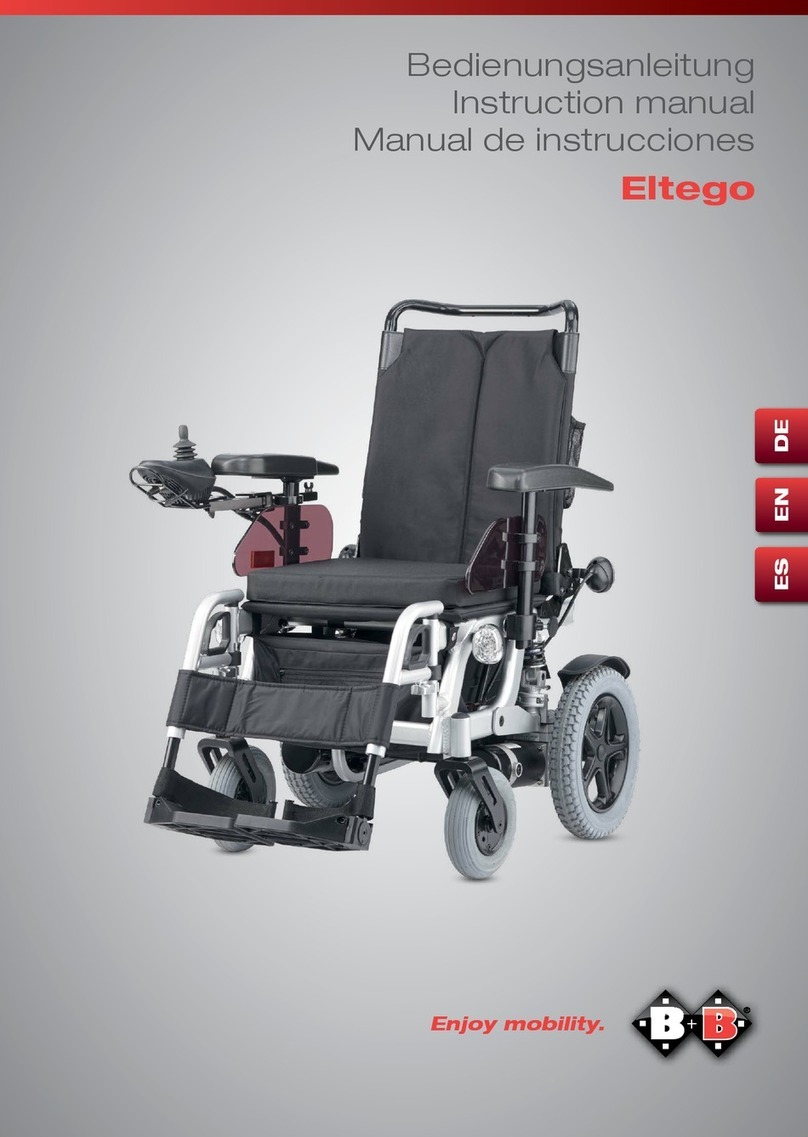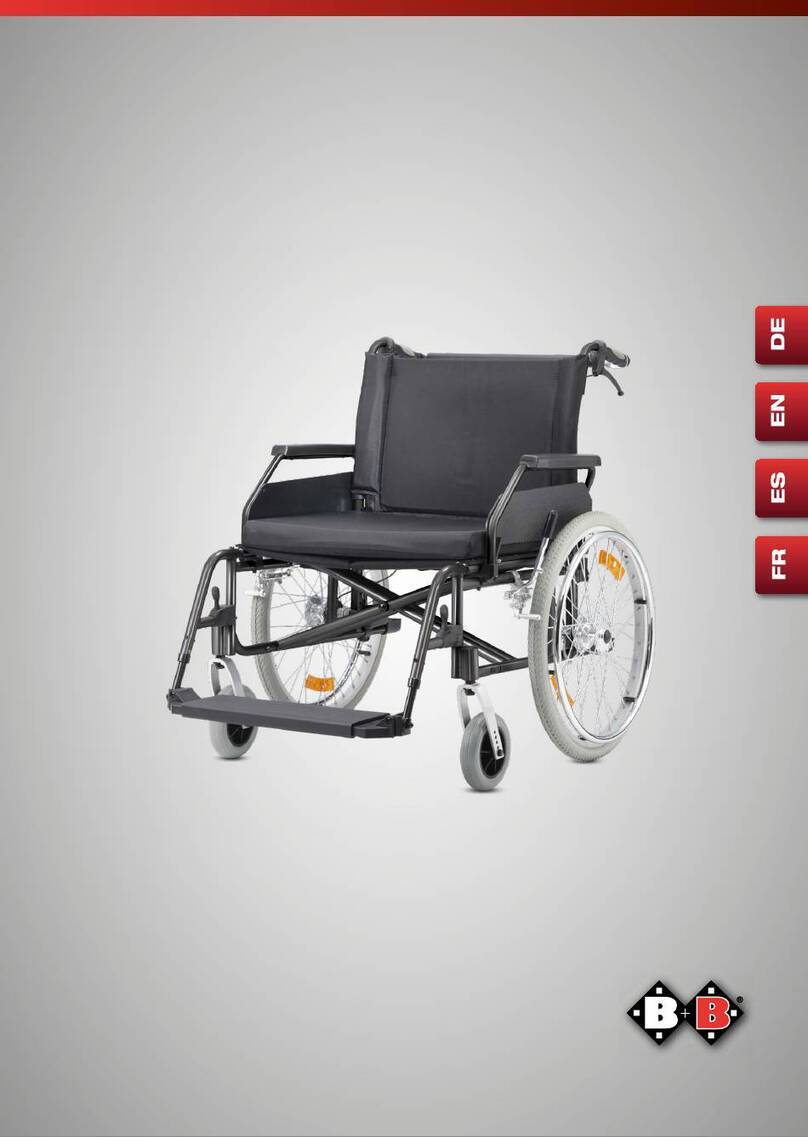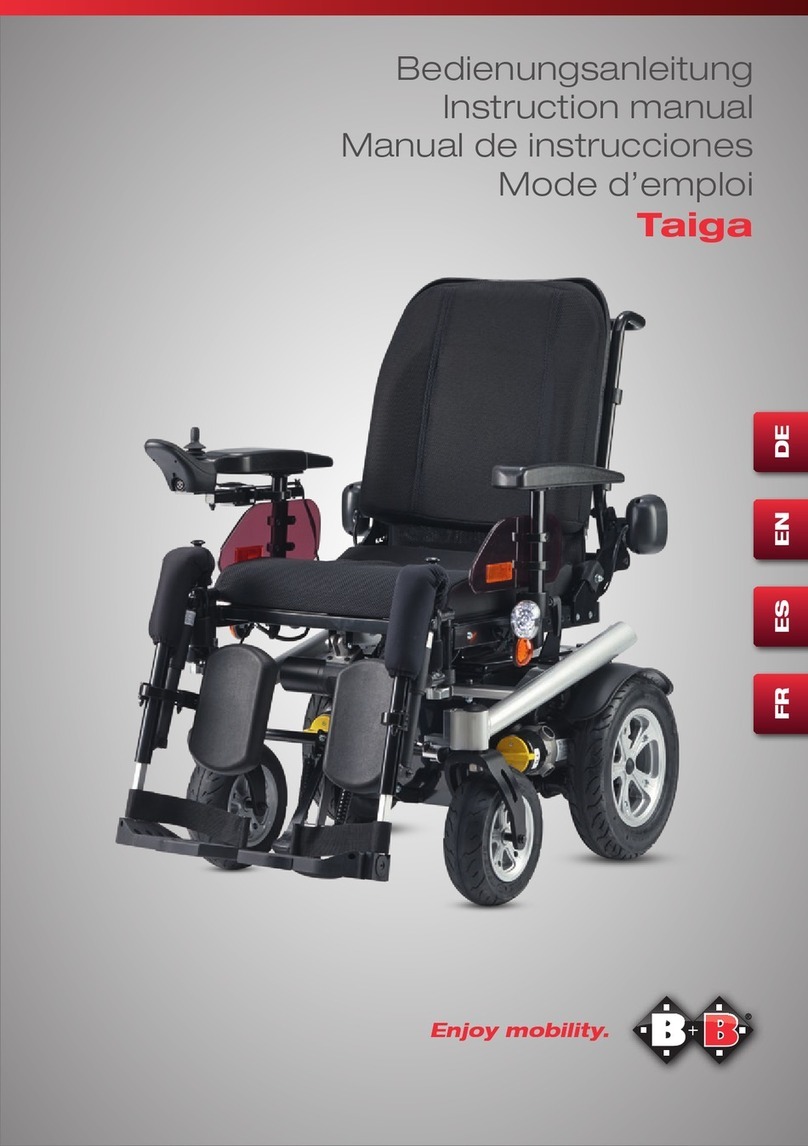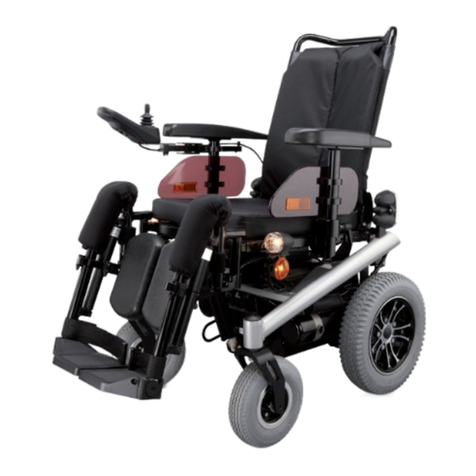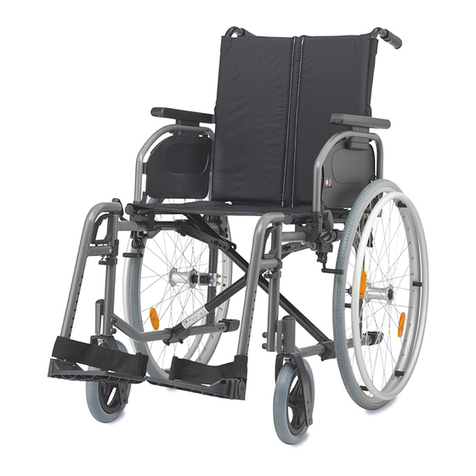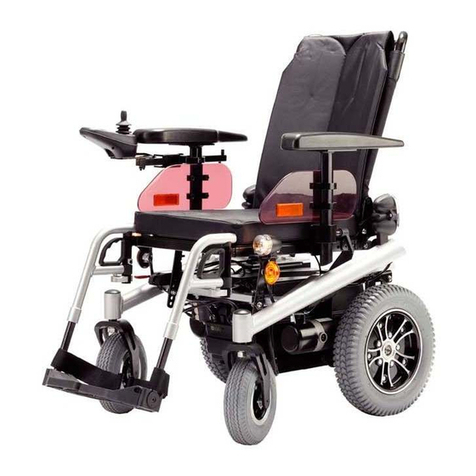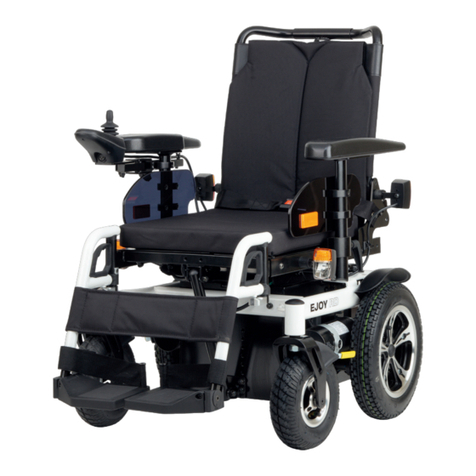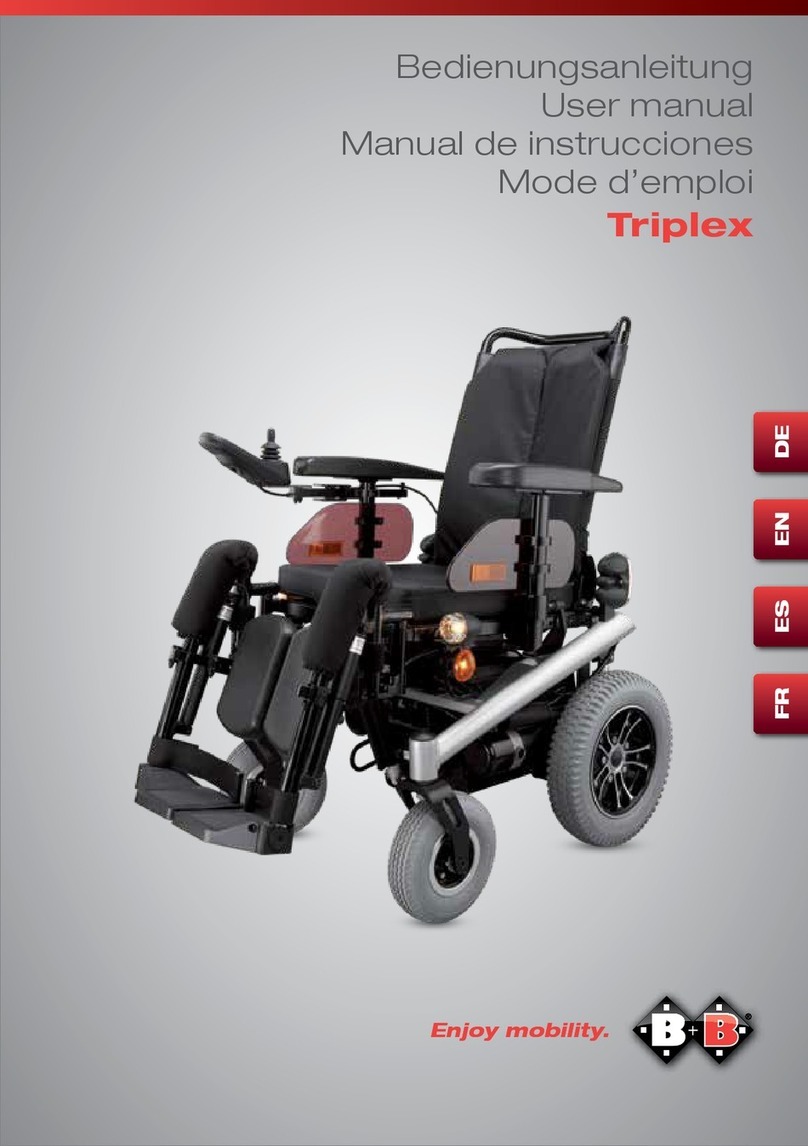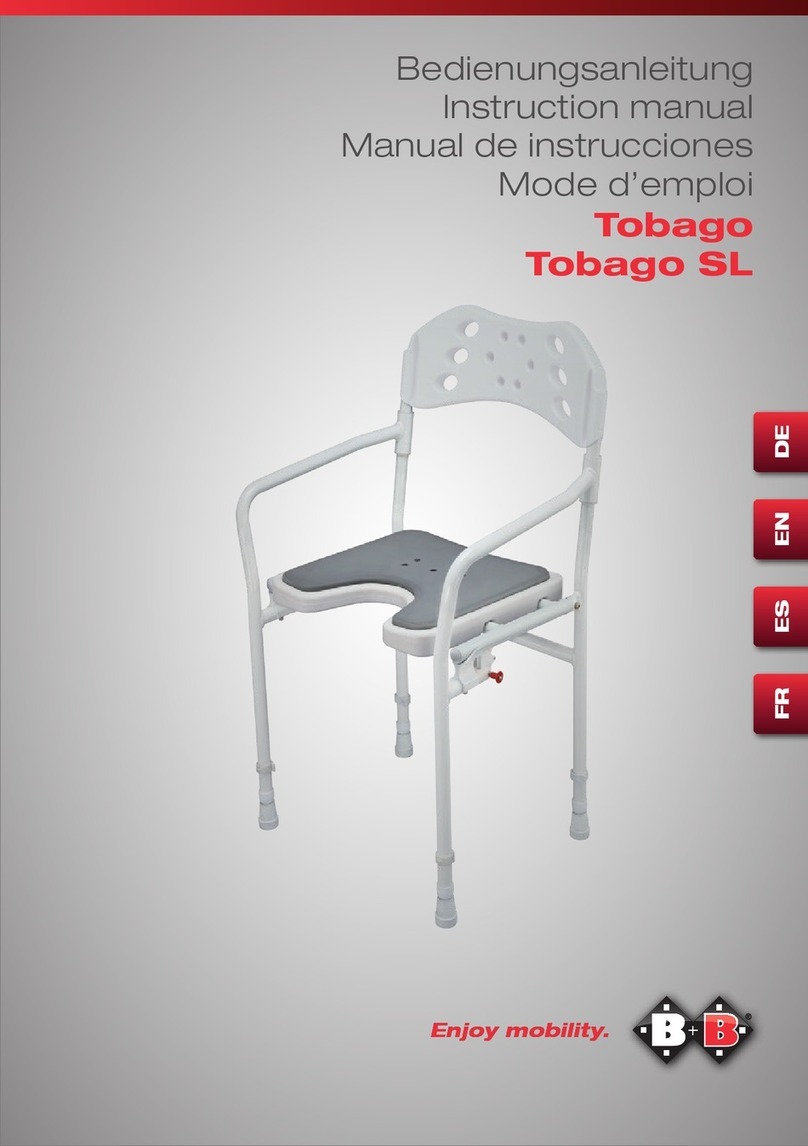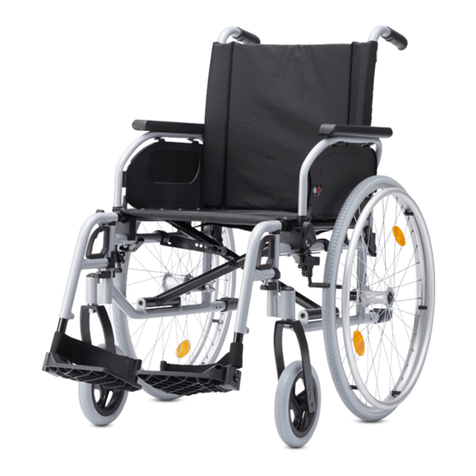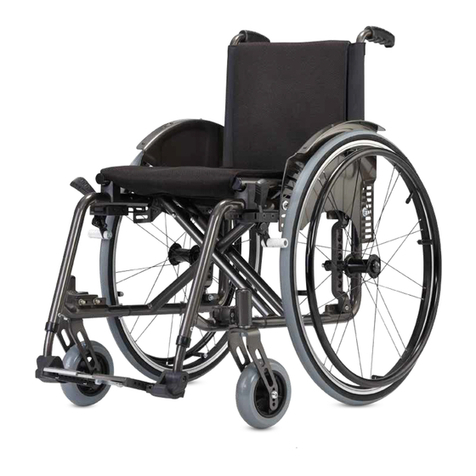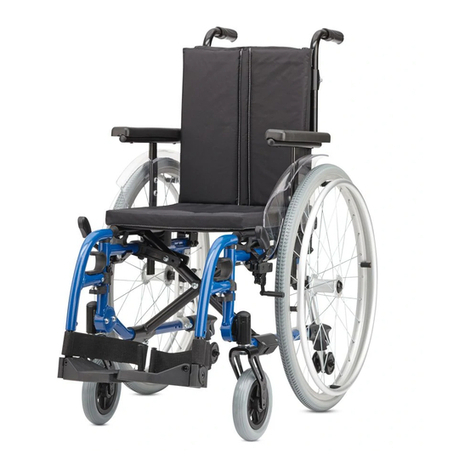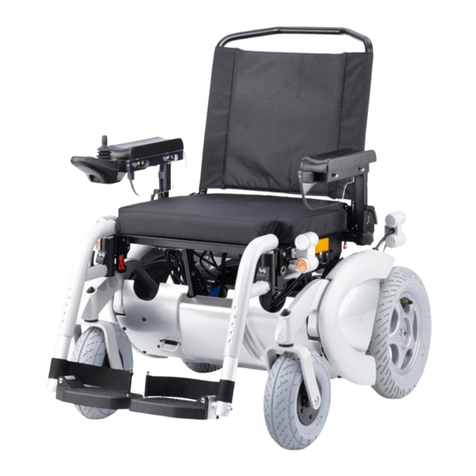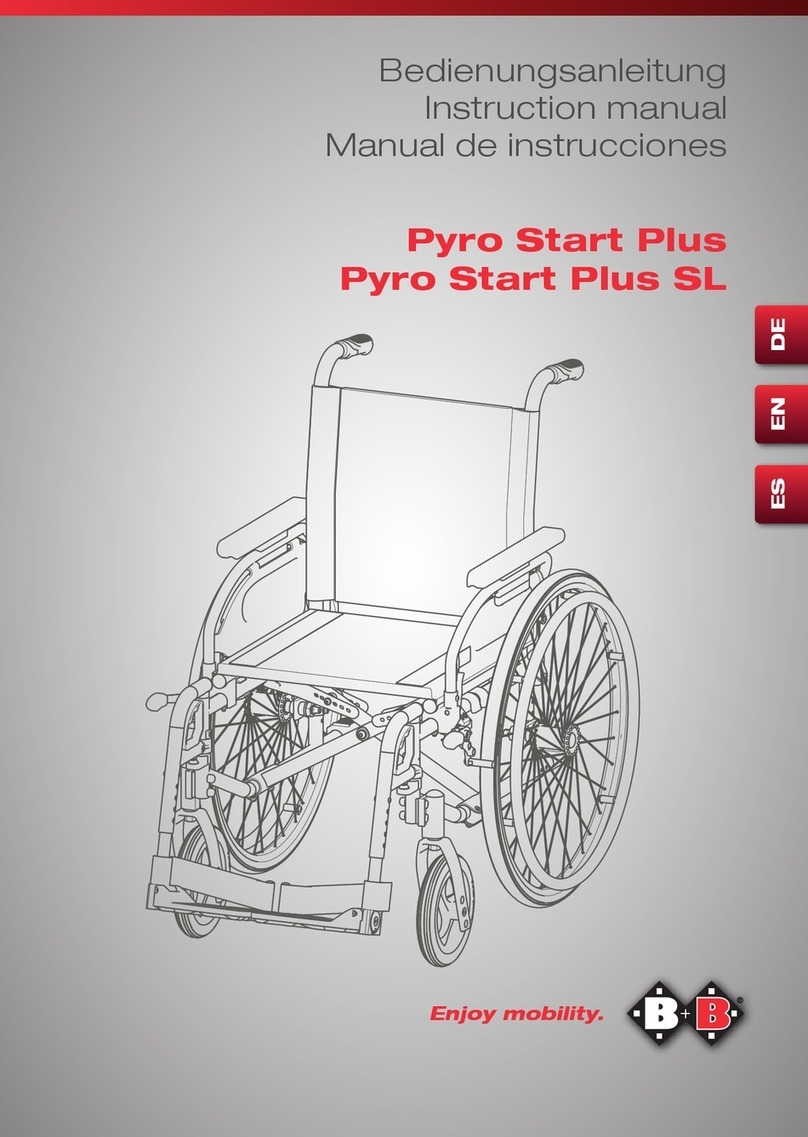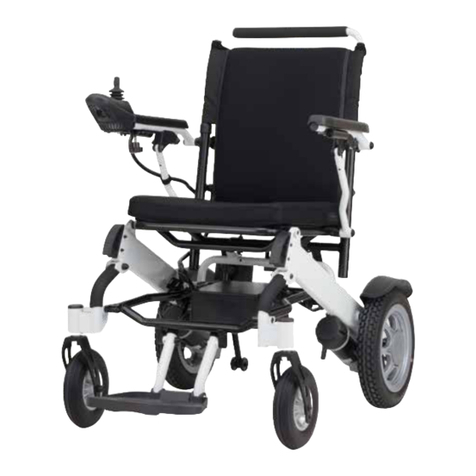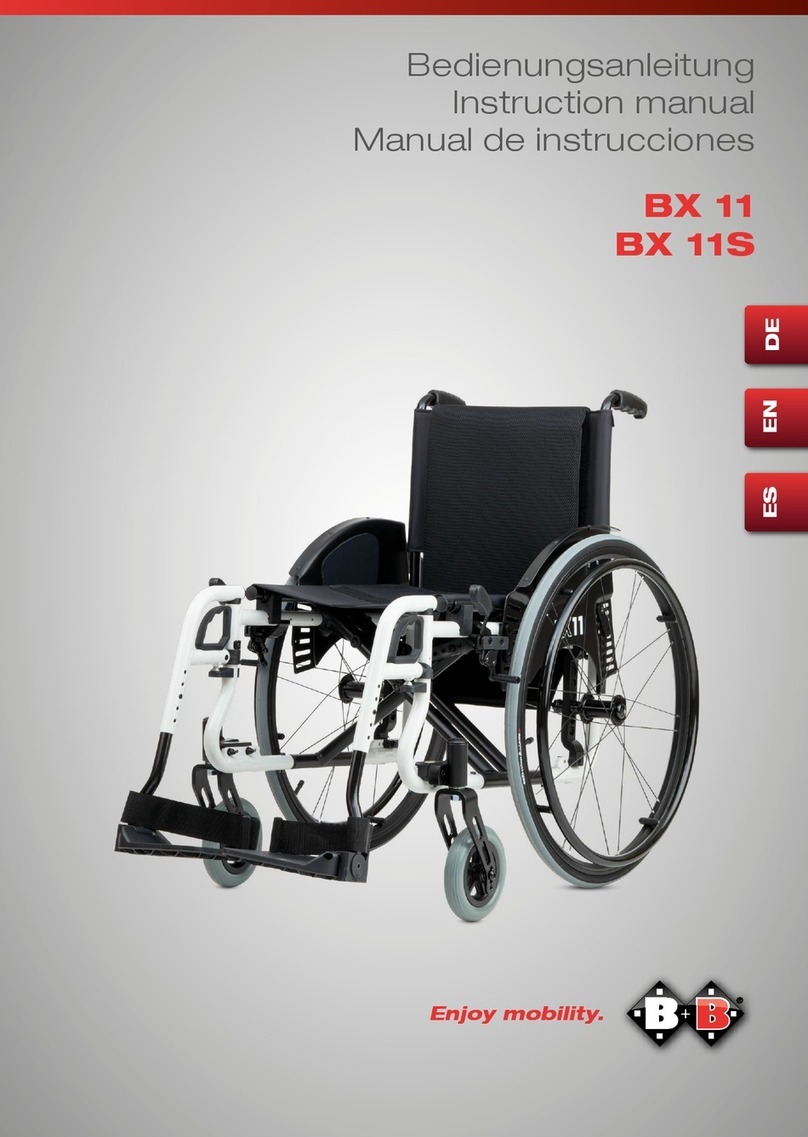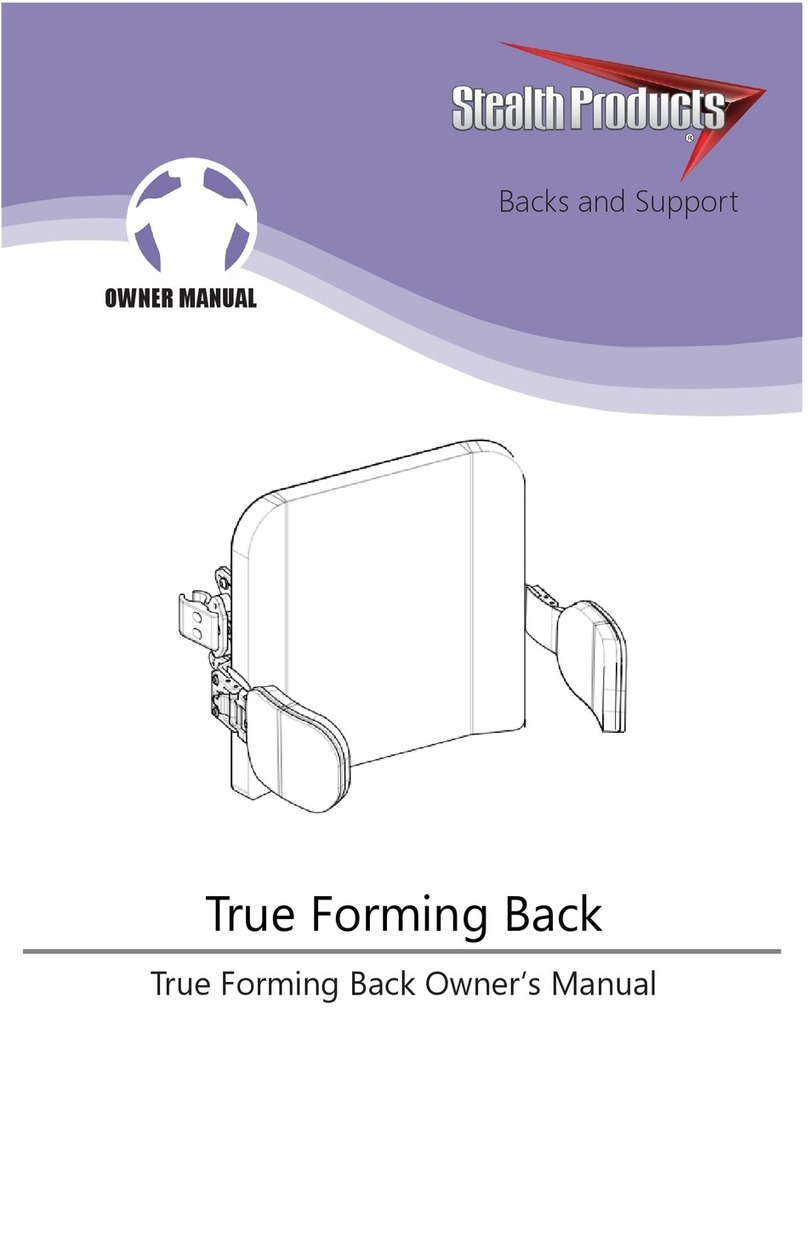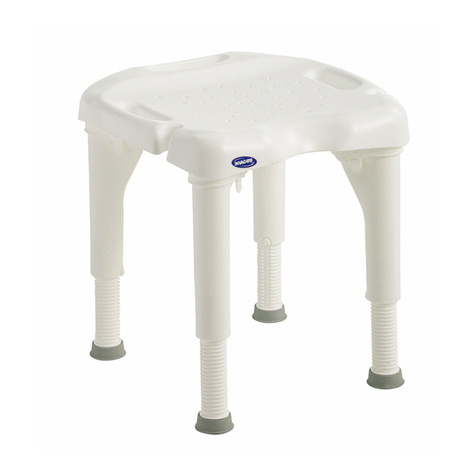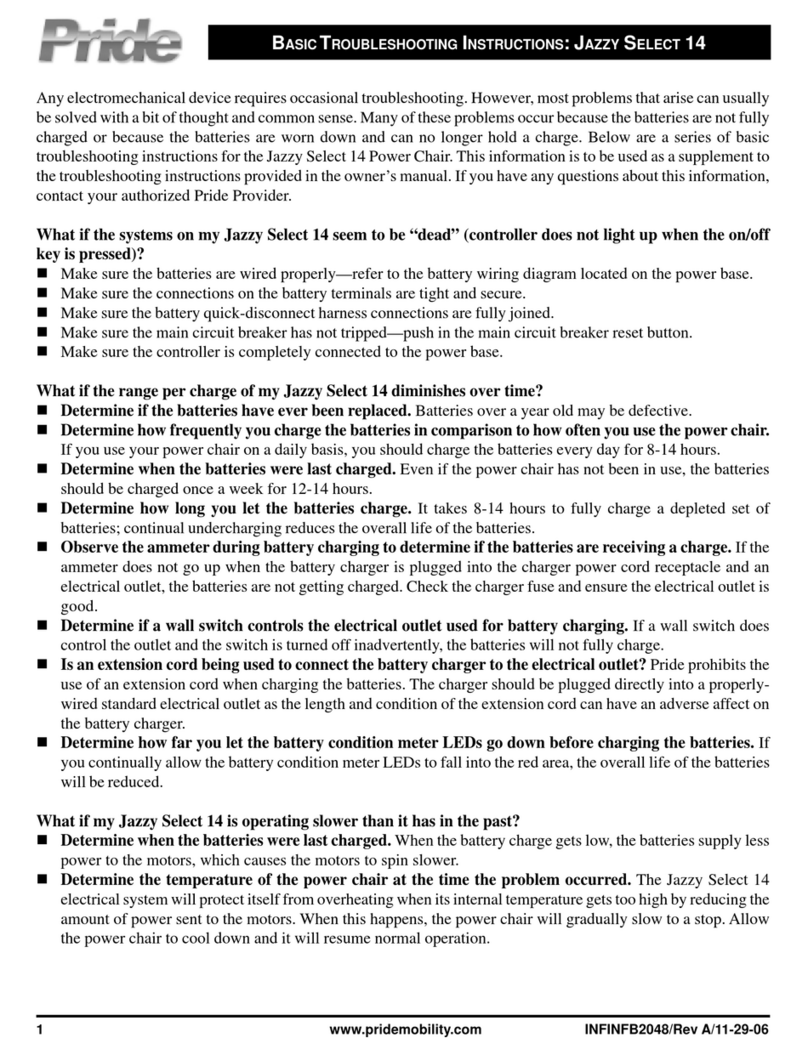B+B Pyrostart User manual

Enjoy mobility.
Bedienungsanleitung
Enjoy mobility.
Instruction Manual
Pyrostart

Bischoff & Bischoff GmbH | 04.07.2018
EN
32
PYRO START | Lightweight wheelchair Lightweight wheelchair | PYRO START
Index
1. Preliminary remark 4
1.1. Signs and symbols 4
2. Important safety instructions 5
2.1. General safety instructions 5
2.2. Brakes 6
2.3. Anti-tip wheels (optional) 6
2.4. Tyres 6
2.5. Obstacles 6
2.6. Steigungen und Gefälle 6
2.7. Use on Public Roads 7
2.8. Purpose 7
2.9. Indications for use 7
2.10. Contraindications 8
2.11. Responsibility 8
2.12. Service life 8
2.13. Declaration of conformity 8
3. Product and delivery overview 9
3.1. Delivery check 9
3.2. Type plate and serial number 10
3.3. Summary 11
3.4. Scope of supply 12
4. Assembly/adjustments 13
4.1. Setting up the wheelchair 13
4.2. Folding up the wheelchair 13
4.3. Foot plates 14
4.4. Leg rests 14
4.5. Tipping lever 15
4.6. Side parts 15
4.7. Parking brake 16
4.8. Seat height 17
4.9. Wheels 17
4.9.1. Driving wheel 17
4.9.2. Steering wheel 18
5. Accessories 18
5.1. Drum brakes 18
5.2. Anti-tip wheels 19
5.3. Lap belt 20
6. Using the wheelchair 20
6.1. Getting in and out from the side 20
6.2. Getting in and out from the front 21
6.3. Moving the wheelchair 22
7. Technical data 24
8. Transport 26
9. Maintenance tips for users 27
9.1. Cleaning and disinfection 27
9.2. Check before use 27
9.2.1. Brake check 27
9.2.2. Inspection of tyres 27
10. Maintenance tips for retailers 27
11. Use by others 28
12. Storage/dispatch 28
13. Disposal 28
14. Warranty 30

Bischoff & Bischoff GmbH | 04.07.2018
EN
54
PYRO START | Lightweight wheelchair Lightweight wheelchair | PYRO START
2. Important safety instructions
2.1. General safety instructions
To avoid falls and dangerous situations, you should first practice driving
your new wheelchair on level, unobstructed ground. We recommend
having an assistant with you.
• Please make sure that all parts have been properly installed before
using the wheelchair.
• To avoid falls and dangerous situations, you should first practice
driving your new wheelchair on level, unobstructed ground. We
recommend having an assistant with you.
• The wheelchair must not be misused by transporting more than one
person or load. Please ensure that you respect the intended purpose
of the product.
• Never operate the wheelchair under the influence of alcohol or other
substances that affect your attention or your physical and mental
perceptive faculties.
• Please note that the risk of tipping may increase due to shifts in
equilibrium caused by body movements or loading of the wheelchair.
• Please note that upholstery parts which are exposed to direct
sunlight become hot and can cause injury to the skin on contact.
You should therefore cover these parts or protect the wheelchair
from solar radiation.
• We recommend the use of leather gloves outdoors. These improve
your grip and simultaneously protect your fingers and palms from
dirt and injury.
• Please be careful of your fingers when setting up the wheelchair.
Risk of entrapment, see “Unfolding” section.
1. Preliminary remark
Dear User
You have chosen a high-quality wheelchair from Bischoff & Bischoff.
Thank you for your trust in our product
The wheelchair was designed to offer you a lot of benefits and to meet
your needs. The Pyro Start wheelchair allows you to adjust the chair‘s
settings to your individual body size and shape thanks to the variety
of adjustment options and optimum adjustability of the seat depth,
backrest height, knee angle, seat width, backrest angle, seat angle and
the length of lower leg.
The wheelchair Pyro Start is intended both for indoor and outdoor use.
Please read and follow the instruction manual carefully before
operating your new wheelchair for the first time. This is an integral
and necessary component of the wheelchair. Keep the instruction
manual where you can refer to it, and if you pass the wheelchair on to
someone else, give the manual to the new owner. For users with visual
impairment, this document is available as a PDF file on our internet
page www.bischoff-bischoff.com. Repairs and adjustments require
special technical training and may therefore only be carried out by
specialist retailers authorised by Bischoff & Bischoff.
1.1. Signs and symbols
Important! This is especially useful information on a
given subject.
Warning! These are especially safety-relevant inst-
ructions. Follow the directions in the manual!

Bischoff & Bischoff GmbH | 04.07.2018
EN
76
PYRO START | Lightweight wheelchair Lightweight wheelchair | PYRO START
2.2.Brakes
The brakes, which work directly on the tyres of the wheels, are only to
be used as parking brakes, which means they must only be applied
when the wheelchair is standing still, not for reducing the speed.
2.3.Anti-tip wheels (optional)
The anti-tip wheels prevent the wheelchair from tipping backwards.
Please note, driving with anti-tip wheels on uneven ground, lift
platforms and ramps is only possible to a limited extent. Ensure
sufficient clearance above, below and on the sides.
2.4.Tyres
Always ensure the tyres have a sufficient tread depth (> 1mm). If the
tread depth is too small, it is no longer possible to guarantee safe
handling of the wheelchair.
2.5.Obstacles
Please always use ramps to drive over obstacles (e.g. steps, kerbs, etc.).
Avoid driving into an obstacle without braking or jumping down from
one level to another.
2.6.Steigungen und Gefälle
Always be aware that your wheelchair can tip over backwards even
on a slight up gradient when the drive axle adjustments are extreme.
Only negotiate up and down gradients with these extreme adjustments
when you an assistant to help you. Also use theanti-tip wheels to
prevent tipping over backwards.
2.7.Use on Public Roads
The wheelchair is designed for indoor and outdoor use. Please keep in
mind that you are using public roads and therefore have to observe all
road traffic regulations.
Do not endanger other road users through inconsiderate driving,
especially on walkways.
2.8.Purpose
The wheelchair is designed solely to increase mobility and to transport
people with impaired mobility in accordance with indications listed.
The maximum user load is 125 kg for the Pyro Start model 1350.
Please note:
We are only able to issue a guarantee if the product is used in
accordance with the specified conditions and for the specified purpose.
2.9.Indications for use
Walking disability or distinct walking impairment due to:
• paralysis
• loss of limb
• extremity defect/deformation
• joint stiffness/damage (not affecting both arms)
• other diseases
Use of a reinforced wheelchair is indicated, if the body weight of the
disabled person is 125 kg or more and a standard wheelchair no longer
guarantees the required safety.

Bischoff & Bischoff GmbH | 04.07.2018
EN
98
PYRO START | Lightweight wheelchair Lightweight wheelchair | PYRO START
2.10.Contraindications
It is improper to use the wheelchair if there is:
• a perception disorder/ perceptual disturbance
• a disturbance of equilibrium
• extremity loss on both arms
• joint stiffness/damage on both arms
• sitting incompetence
• educed or insufficient eyesight
2.11. Responsibility
We can only ensure safety if the product is used under the given
conditions and for the mentioned purposes. Changes, enlargements,
repairs and maintenance jobs can be done only by authorised people.
When using the wheelchair, please follow all the operating instructions.
2.12.Service life
If used as intended, and the safety, care and maintenance instructions
are observed, the expected service life is up to 5 years. Beyond this
time, the wheelchair can be used continuously, provided the product
is in a safe condition.
2.13.Declaration of conformity
As manufacturer of the product, B+B declare that the “Pyro Start”
wheelchair complies fully to the requirements of the European Directive
93/42/EWG (EEC) for medical products.
3. Product and delivery overview
3.1. Delivery check
The Pyro Start wheelchair is delivered fully assembled in a carton. After
unpacking, please retain the carton if possible. It can be used to store
or return the wheelchair at a later stage.
Delivery of the wheelchair and instructions on its use are carried out by
qualified and authorised medical supply dealers.
If shipped by rail or a forwarding agent, the goods are to be immediately
checked for transportation damage (carton) in the presence of the
delivery company. If there is any damage, please contact our customer
service department immediately (tel.: + 49 (0)700/6000 7070).
Check that the contents are complete and intact. In the event of
irregularities or damage, contact our customer service department
(tel.: + 49 (0)700/6000 7070).

Bischoff & Bischoff GmbH | 04.07.2018
EN
1110
PYRO START | Lightweight wheelchair Lightweight wheelchair | PYRO START
Push handles
Armrest
Side part
Parking brake
Leg rest
Quick release axle
Liftting points
Food plate
swiveling wheel
1a
Bischoff & Bischoff GmbH
Becker-Göring-Straße 13
D - 76307 Karlsbad
Telefon 0700 - 60007070
GB
CE Sticker & EAN Codes (Size 80 mm x 23 mm)
Manual Wheelchairs (crash tested)
EAN 13 SN
Model: Pyro Start
Model no.: 1350 2018-05 Max. weight capacity : 125kg
Manufacturer logo
Manufacturer information
Caution! - Follow instructions for use
CE mark
Follow instructions regarding securing the product in the vehicle
Important - Adhere to the operating instructions
Model designation
Date of manufacture
Maximum weight capacity
Model number
EAN 13 item number
Serial number
A
B
C
D
E
F
G
H
I
J
B C
01
A D
E F
G H I
J
K
K
L
L
3.2.Type plate and serial number
The type plate (fig. 01) and serial number are located on the bottom
of the frame.
3.3.Summary
To make the use of your B+B wheelchair as simple as possible,
we have provided detailed illustrations in addition to the written
instructions in the documentation.
The following illustration should help clarify the names and
interactions of the individual components for you.
Please note the sections of text that are specially marked.

Bischoff & Bischoff GmbH | 04.07.2018
EN
1312
PYRO START | Lightweight wheelchair Lightweight wheelchair | PYRO START
3.4.Scope of supply
The contents comprise the following main components:
• wheelchair, pre-assembled
• 1 pair of leg rests
• 1 instruction manual
• 1 air pump (only for pneumatic tyres)
4. Assembly/adjustments
4.1. Setting up the wheelchair
To unfold your wheelchair after unpacking, please move close to the
wheelchair.
• With one hand, grasp the armrest or the seat tube on one side of the
wheelchair and tip it towards you (Fig. 2).
• With the other hand, push the crossbrace apart until the seat tube
rests fully in the plastic mounting (Fig. 3).
• The seat cushion must be fully extended.
• Activate the parking brakes on the right and left drive wheels.
• Clip in the leg rests.
• Now you can sit down.
4.2.Folding up the wheelchair
To fold up your wheelchair, first swing the foot plates upwards (Fig. 4).
•Move close to the wheelchair.
•Grip the seat cushion at the front and back and pull it upwards (Fig.
5). To stow the wheelchair in a car, you can easily remove the rear
wheels via the quick-release axle.
.
RISK OF ENTRAPMENT! Make sure that you do not
grip the seat tube.
5
2
3
4

Bischoff & Bischoff GmbH | 04.07.2018
EN
1514
PYRO START | Lightweight wheelchair Lightweight wheelchair | PYRO START
4.3.Foot plates
• The lower leg length can be continuously adjusted by 12 cm.
• To do this, loosen the socket head screw (SW 5) (Fig. 6).
• Set the desired height. (Fig. 6).
• The foot plates must be folded upwards and swung to the side when
getting into or out of the wheelchair.
4.4.Leg rests
• So that you can get in and out of the wheelchair as easily as
possible, you can fold the foot plates upwards, swing the leg rests
away outwards or take them out by pulling upwards.
• To swing the leg rests away outwards, open the locking mechanism
(Fig. 7).
• When the leg rests are in the “outward position”, they can be
completely removed. (Fig. 8).
• To assemble the leg rests, proceed in the reverse order.
• Swing the leg rests forwards again until you clearly hear them click
into place.
Caution! The maximum extension length is indicated
on the side with a mark.
4.5.Tipping lever
• The tipping lever makes it easier for an assistant to tilt your
wheelchair, in order to negotiate a step for example.
• To do this, push the lever down using your foot (Fig. 9).
• Use the push handles to keep the balance.
• The tipping lever protrudes on the right and left of the frame and is
fitted with rubber profiles to ensure sufficient grip.
• As an option, anti-tip wheels with an integrated tipping lever can be
fitted instead of rubber profiles.
4.6.Side parts
• In order to be able to get in / out more easily, both side parts and
the armrests can be swung backwards.
• Activate the locking lever using light finger pressure and swing the
side part away backwards at the same time (Fig. 10).
• To lock the side part, fold it forwards and click it into place with light
pressure on the armrest (Fig. 11).
When swinging the side parts, ensure that no artic-
les of clothing or other items can become jammed.
Check the side parts are firmly seated before starting
to use!
Do not use the side parts to carry the wheelchair!
6
7
8
9
10
11

Bischoff & Bischoff GmbH | 04.07.2018
EN
1716
PYRO START | Lightweight wheelchair Lightweight wheelchair | PYRO START
• The arm supports for the side parts (desk/long) are fitted as desk
(short) on delivery.
• They are switched to long by turning the arm support through 180°
and mounting on the opposite side part (Fig. 12).
4.7.Parking brake
The Pyro Start is equipped with a tyre brake which can be controlled
by the person sitting in the wheelchair. It must only be used to park
the wheelchair. It is not suitable for slowing down the wheelchair
while it is in motion! The push rims should be used for this purpose, by
applying light pressure on them with the palm of your hands. Once the
wheelchair has been slowed down this way, apply both tyre brakes by
pushing the brake levers forwards. The wheelchair is now safely held
in place.
• The gap between the pivot bolt and the tyre cover must be X = 15
mm at the narrowest point when the braking mechanism is opened
to its maximum position (Fig. 13).
• To adjust the gap, loosen the two Allen screws on the brake mounting
(underside - Fig. 14).
• You can then slide the braking system along the mounting into the
correct position.
• The braking bolt must be aligned horizontally, that is parallel to the
ground surface.
• Then tighten both Allen screws up again.
• Make sure that the brake fully locks into place when the lever is
operated and that it does not snap back.
Adjustment of the brakes should be carried out by
specialist trained staff. However, if you have enough
experience, you can also carry out this work yourself.
Nevertheless, please bear in mind that incorrectly
adjusted brakes may have life-threatening conse-
quences.
To ensure the brake operates to its maximum capa-
bility, there must be a tyre pressure of 300 - 400 kPa
(3-4 bar) for pneumatic tyres! If the tyre pressure is
not as specified, there is a loss of braking efficiency!
4.8.Seat height
There are 3 positions allowing the seat height to be adapted to the
user‘s requirements.
Driving wheel and steering wheel must be in the same position in each
case. TOP – MIDDLE – BOTTOM
4.9.Wheels
4.9.1.Driving wheel
• Take the driving wheels off using the quick-release axle.
• Loosen the screws on the adapter (Allen key, SW 4 and ring spanner
SW 10) and pull them out completely (Fig. 15).
• Place the adapter at the required seat height.
• Reinsert the screws into the adapter and tighten them up again. 15
12
13
14
x = 15 mm

Bischoff & Bischoff GmbH | 04.07.2018
EN
1918
PYRO START | Lightweight wheelchair Lightweight wheelchair | PYRO START
4.9.2.Steering wheel
• First, remove the masking on the optional drill holes.
• Loosen the axle (Allen key, SW 4) and take it out completely.
• Place the steering wheel in the right position for the required seat
height (Fig. 16).
• Reinsert the axle into the steering fork and tighten it up again.
Place the steering wheel in the same hole position
as the drive axle. This is the only way to ensure good
directional stability of the wheelchair.
5. Accessories
5.1. Drum brakes
As an option, the Pyro Start can be equipped with a drum brake, which
should only be operated by an assistant via the brake lever on the push
handles. The drum brake should be used as both a parking brake and
also as a service brake. When used as a service brake it provides well-
regulated deceleration. The locking brake function is used for parking.
• To lock the brake, simply pull the brake lever and push the locking
lever upwards (Fig. 17).
• To release the parking brake again, simply pull the brake lever briefly.
(The locking mechanism releases automatically.)
To achieve optimum braking efficiency, the braking power is set
using the adjusting screw (Fig. 18). The braking power is increased by
loosening the adjusting screw and reduced by tightening it.
• Please loosen the adjusting screw until you notice friction noises on
the wheel when it is turning.
• Then tighten the adjusting screw until the friction noises disappear.
The wheel then runs freely.
• After completing the setting, the adjusting screw is fixed by
tightening the locknut.
5.2.Anti-tip wheels
Always use the anti-tip protection as a pair
The anti-tip wheels prevent the wheelchair from tipping over backwards.
There must be a gap of 3-5 cm between the anti-tip wheels and the
ground (Fig. 19).
Besonders empfehlenswert sind die Antikipprollen bei ungeübten
Rollstuhlfahrern oder bei beinamputierten Rollstuhlfahrern.
• The anti-tip wheels are attached as a pair to the right-hand and left-
hand sides of the frame.
• First, pull the tipping lever’s rubber profile off the frame.
• Push the round profile of the anti-tip wheels onto the side frame
tube
• Now, screw on the anti-tip protection with the M6 x 35 screw and
the M6 self-locking nut in the hole provided.
19
18
17
16

Bischoff & Bischoff GmbH | 04.07.2018
EN
2120
PYRO START | Lightweight wheelchair Lightweight wheelchair | PYRO START
5.3.Lap belt
There is also an optional lap belt available to order which secures
wheelchair users who do not have the required stability for sitting in a
wheelchair (Fig. 20).
• The Pyro Start can be equipped with a seat belt on the backrest
tube.
•Use the buckle to open and close the belt.
•The length of the belt can be adjusted using the movable latch on
the belt.
6. Using the wheelchair
6.1. Getting in and out from the side
• Move the wheelchair and the current or future seat as close beside
one another as possible.
• If you want to switch from another wheelchair or indoor frame,
secure it by activating the locking brakes.
• Secure the Pyro Start to prevent it rolling away unintentionally by
activating the brake lever on the left and right hand sides of the
wheelchair.
• Swing away the padded armrest to the back.
• Fold the foot plates to the side or remove the leg rests.
• Now slide sideways onto the other seat.
• Make sure that you sit as far back as possible in the seat.
• Finally, return the leg rests to their original position.
Never climb on the foot plates! RISK OF TIPPING!
6.2.Getting in and out from the
front
• First swing the foot plates up or remove the leg rests.
• Move the Pyro Start and the current or future seating as close as
possible to the front of one another.
• If you want to switch from another wheelchair or indoor frame,
secure it by activating the locking brakes.
• Now slide onto the seat by turning your body.
• Finally, return the leg rests to their original position.
20

Bischoff & Bischoff GmbH | 04.07.2018
EN
2322
PYRO START | Lightweight wheelchair Lightweight wheelchair | PYRO START
6.3. Climbing stairs and high steps
Where steps are high and where there are stairs with
more than 3 steps, 2 assistants must help.
• The helpers must only take hold of securely fitted parts of the frame
(Figs. 21 and 22).
• When going up stairs, the helper behind the wheelchair pulls the
wheelchair over the step holding it by the securely fitted handles.
• The helper who is below the chair takes hold of the front frame
tubes and stabilises the position. At the same time, this helper
pushes the rear wheels of the wheelchair against the steps.
• When going down stairs, the helper who is below the chair brakes
by pushing the wheelchair right against the steps. The helper who
is above the wheelchair holds it by the push handles, secures it and
holds it in the right position. The wheelchair should roll down step
by step.
The frame and the push handles are the only places
where the wheelchair can be gripped to transport it.
Under no circumstances should armrests be used to
lift the wheelchair!
6.3. Moving the wheelchair
Sit down in your B+B wheelchair. Make sure that you sit as far back as
possible. Moving and braking are achieved via the push rims on the
drive wheels. Make the first attempts at movement carefully until you
are used to the wheelchair and how it handles. Wheelchairs have only
limited anti-tip and anti-slip security. Particular care is advised when
braking, starting or turning on up or down gradients .
Leaning an extremely long way out of the wheelchair increases the risk
of tipping over. For greater safety, all wheelchairs can be equipped with
a safety belt (not standard).
You can hang shopping bags or a rucksack on the backrest frame. To
make it easier to negotiate obstacles, staff assisting you must position
the wheelchair at a right angle to the obstacle by pressing the tip assist
with the foot (see Fig. 9).
The parking brake must be activated before getting into / out of
the wheelchair. You should only travel outside the home if you have
sufficient experience in handling the chair. If possible, there should be
someone accompanying you.
The static stability is 7° (approx. 12%) on the basic model.
The critical obstacle height* is 23 mm on the basic model in an
unfavourable situation (max. shift of centre of gravity to the back).
*The critical obstacle height is the height at which the centre of gravity
(with the user) is directly above the edge of the obstacle. If the user
tries to move the wheelchair over the obstacle by propelling the driving
wheels, without now shifting the centre of gravity forwards, then the
wheelchair will tip over backwards.
According to the German traffic regulations (STVZO
66/1) dated 1/1/1981, manually operated
wheelchairs travelling on public roads (including
pavements) must have permanently attached
illumination.
This comprises (passive):
• two red reflectors at the back
• two yellow reflectors on the side (on both sides).
If the wheelchair is used after dark, the following are also required
(active):
• one white light at the front
• one red light at the back.
The functioning of these lights must be ensured by an electrical circuit
(batteries) that is independent of the driving operation.
22
21 21

Bischoff & Bischoff GmbH | 04.07.2018
EN
2524
PYRO START | Lightweight wheelchair Lightweight wheelchair | PYRO START
Environmental conditions
Temperature (°C): 35
Humidity (%): 80
Storage conditions
Temprature (°C): 40
Humidity (%): 80
Tyres
Driving wheels 24“ x 1
3
/
8
“ (flat-proof)
Steering wheels: ø 8“ x 1 ¼“ (flat-proof)
Marerial
Frame: Aluminum powder coated
Armrest cushion: PU foam
Seat-/back cushion: Nylon with foam
Upholstery flame-retardant to EN 1021-1 and 2
7. Technical data
Dimensions
Seat width: 37/40/43/46/49/52 cm
Seat depth: 42 cm
Seat hight front edge: 47/49/51
Seat plane angle: 2-3°
Overall width: Seat with +19 cm
Overall length: 99/77,5 cm (with/without Legrest)
Overall height: 87/89/91 cm
Backrest height: 40 cm
Lower leg length: 30 – 42 cm (continuous)
Backrest angle: 10°
Food plate angle: 15° (without adjustment)
Knee angle: 115° (without adjustment)
Hight of the armrest: 22 cm
Length of the armrest: 34 cm
Dimensions when folded: 01/33/91 cm (L/W/H)
Masses
Max. user load: 125 kg
Empty weight: ab 16,1 kg
Frame weight: 9,0 kg
Driving characteristics
Min. turning radius: 750 mm
Pivot width: 1150 mm
Stability
Static uphill/downhill (°): 12,9 / 15,3
static stability sideways (°): >15

Bischoff & Bischoff GmbH | 04.07.2018
EN
2726
PYRO START | Lightweight wheelchair Lightweight wheelchair | PYRO START
9. Maintenance tips for users
9.1. Cleaning and disinfection
• The frame and the paneling of the wheelchair can be cleaned with
• a moist cloth. You can use a mild detergent for more stubborn dirt
• The wheels can be cleaned with a wet synthetic fiber brush (do not
• use a wire brush!)
• Push handles, arm pads, and seat and back pads can be washed
• off. Use mild detergent.
• Use a disinfectant listed by VAH for disinfection.
Observe our included overview of the most important care, hygiene
and maintenance work.
9.2. Check before use
9.2.1. Brake check
Make sure your brakes are operating properly before each use. It should
not be possible to push the wheelchair away while the brakes are
activated.
The wheelchair should be easy to drive without grinding noises and
with good direction stability when the brakes are released.
If you notice unusual behaviour when braking, inform your mobility
dealer immediately and do not use the wheelchair .
9.2.2. Inspection of tyres
Before embarking on any journey, check that the tyres are in good
condition.
8. Transport
You can determine whether or not your wheelchair is approved for use
as a seat in a vehicle for transporting disabled people by referring to
the symbols on the CE sticker on the product:
Wheelchair suitable for use as a seat in a vehicle for
transporting disabled people (fig. A)
Wheelchair not suitable for use as a seat in a vehicle for
transporting disabled people (fig. B)
All products approved by B+B for use as seats in vehicles are tested
in accordance with ISO 7176-19. The tests in accordance with ISO
7176-19 were performed using restraint systems from AMF-Bruns. The
correct mounting of the restraint system is a prerequisite for the safe
transportation of the products in a vehicle for transporting disabled
people and the basis for the approval.
Fixation points on the restraint system (fig. C)
The restraint systems from AMF-Bruns provide the ideal points for the
provision of restraint force for the purpose of securing the products in
the vehicle for transporting disabled people (known by the German
term „Kraftknoten“, which is defined in the standard DIN 75078-2).
For the purpose of providing restraint in the vehicle for transporting
disabled people (fig. C), the products must only be secured at these
specific points („Kraftknoten“ points). If possible, use a permanently
installed car seat and its belt system. Stow the wheelchair in the
luggage space. The person responsible for the transportation should be
familiar with the current regulations for transportation as well as with
the method of operating the vehicle for transporting disabled people
and the restraint system.
Anchored 4-point restraint systems must be used to secure the
wheelchair in the vehicle.If you have any queries about securing your
product in a vehicle for transporting disabled people, please contact
the B+B customer service department on +49 (0)700/60007070.
A
B
C

Bischoff & Bischoff GmbH | 04.07.2018
EN
2928
PYRO START | Lightweight wheelchair Lightweight wheelchair | PYRO START
10. Maintenance tips for retailers
We recommend to have the entire wheelchair inspected by an
authorized dealer at least once a year.
Should the wheelchair be faulty or defective, it should be brought to an
authorized dealer for repair without delay.
Repair and replacement of parts are carried out by an authorized
mobility dealer.
All information, documents and schematics necessary for repair are
made available to the authorized dealer on request. There is also a
training program for authorized dealers.
Should you have any questions, please contact the B+B customer service
at +49 700 - 6000 7070.
The wheelchair shall be inspected in accordance to
the service schedule and must be in good condition
11. Use by others
The Econ XXL is appropriate for use by others. For use by others, the
wheelchair must first be thoroughly cleaned and disinfected according
to the accompanying care and hygiene instructions.
The product shall get checked by an authorised mobility dealer for
general condition, wear and shall get repaired if necessary.
12. Storage/dispatch
If the wheelchair is going to be stored or transported, all removable
and not tightened parts, except of the drive wheels, have to be removed
and packed in separate cartons. The separately packed parts can be
packed together in a larger carton.
It is recommendable to keep the original packaging for this purpose, so
that it is available in case you need it. In that way your wheelchair is
protected against environmental influences during storage or transport.
13. Disposal
Even a worn-out wheelchair represents a valuable source of materials
which can be fed into the industrial cycle again.
Do not therefore throw your wheelchair away with the household waste
when is ready for disposal, but have it professionally disposed of by
a state-accredited waste disposal centre. Your local waste collection
organisation will be happy to give you appropriate information. The
environment will thank you for this.

Bischoff & Bischoff GmbH | 04.07.2018
EN
3130
PYRO START | Lightweight wheelchair Lightweight wheelchair | PYRO START
14. Warranty
Guarantee items refer to all defects of the wheelchair which can
demonstrably be referred to material defect or manufacturing defect.
If there are complaints you have to provide a completed certificate of
guarantee.
Non-observance of the operating instructions as well
as improper use, maintenance jobs and technical
changes or adaptions without the permission of the
Bischoff & Bischoff company, lead to guarantee loss
and the loss of product liability in general.
We provide the statutory warranty of 2 years for our products. For
batteries, replacement devices and repairs, a warranty period of 1 year
applies.
Please also observe the B+B care, warranty, hygiene and maintenance
instructions. Your qualified mobility dealer will be happy to provide
these to you.
Tip!
In spite of careful research and editing, incorrect information may
have crept into our operating manuals. The current version of each
instruction manual is ready for download at the B+B website:
www.bischoff-bischoff.com

Bischoff & Bischoff GmbH
Becker-Göring-Straße 13
D-76307 Karlsbad
www.bischoff-bischoff.com
Table of contents
Other B+B Wheelchair manuals
